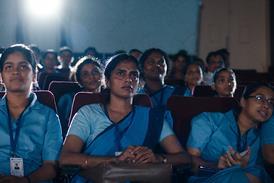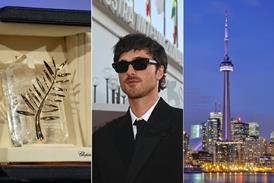France has long been a model of cinema-going culture. But with a box-office drop in 2013, a dip in local production and cinema audiences getting older, Melanie Goodfellow looks at the future of film culture in the digital age.
Abel Ferrara’s Welcome To New York — starring Gérard Depardieu in a role inspired by the downfall of former IMF chief Dominique Strauss-Kahn — is one of the most anticipated films of the year in France.
Yet this buzz won’t be building in cinemas. Wild Bunch announced in April it will premiere the film on VoD in France. The move challenges the territory’s media chronology law that demands a four-month window between cinema and VoD release (and 36 months between theatrical and SVoD). It also means the picture won’t be in cinemas.
“France is one of the only countries in the world where it’s against the law to show it on VoD and in the cinema at the same time,” says Wild Bunch co-chief Vincent Maraval. “The French media chronology laws are idiotic. They were created prior to the internet age and are anachronistic.”
The company plans a $1m promotional campaign, kicking off with an event on the fringes of Cannes Film Festival attended by Ferrara and Depardieu, followed by the VoD release in France and across Europe. “We have the biggest cinema theatre in the world, it’s called the internet,” says Maraval.
When news of the plan broke in France some commentators said it sounded the death knell for the country’s media chronology legislation, which is one of the cornerstones of its envied film finance and distribution system.
Other challenges
But the move comes at a tough time for the French film industry on a number of fronts. “The cinema industry is always going through change and you just have to keep adapting but there’s been a perfect storm of two economic factors and one structural one over the last 12 months,” says producer Marie Masmonteil of Paris-based Elzevir, who is also president of France’s Syndicate of Independent Producers (SPI).
The economic challenges, she says, comprise last year’s 10 million dip in spectators at the box office, to 192.8 million from 203.6 million, and the introduction of a collective labour accord for crew that has upped production costs at a time when funding is tight.
“A number of commercial French films flopped last year, which has made distributors wary of investing in local productions,” says Masmonteil, noting the French share of the market fell to some 31% in 2013 against 41% the year before.
‘The French media chronology laws are idiotic. They were created prior to the internet age and are anachronistic’
Vincent Maraval, Wild Bunch
“Added to this the ‘collective convention’ has bumped up costs on lower-budget films by $278,000 (€200,000) to $416,000 (€300,000). It’s unlikely we would have green-lit any of our recent films under the new accord,” adds Masmonteil, who produced Un Certain Regard opener Party Girl alongside Elzevir partner Denis Carot.
French production is down by 50% year on year, adds Masmonteil, who predicts there are 180 to 200 local films to be made this year against some 270 in 2013.
Media chronology is also an issue, although she notes it is not so much VoD as SVoD, which is her syndicate’s chief concern.
“We’re not so worried about transactional VoD but rather SVoD. We’re lobbying hard for the 36-month window to be retained, rather than reduced to 18 or 24 months as some are suggesting,” she says. “It’s vital the broadcasters come before the streaming services.” Not least, she notes, because pay-TV operator Canal Plus, state channels and private stations such as TF1 and M6 provide some $485.5m (€350m) worth of finance, while the likes of Netflix and Amazon put nothing into French content.
Cinema’s draw
Veteran distributor and producer Jean Labadie of Paris-based Le Pacte, meanwhile, doubts Wild Bunch’s initiative will radically change media chronology.
“It works for that film because it’s a very particular case and doesn’t involve any French broadcasters,” he says of Welcome To New York, which is produced out of the US.
He also holds that the French still love to see films in theatres. “Yes, last year the box-office figures were bad but this year they’ve come back. You only need to look at the annual box office which regularly comes close to 200 million spectators to understand we still love cinema,” he says.
French cinema has already bounced back this year with a series of hit comedies including Dany Boon’s Superchondriac, which drew more than 5 million spectators, rom-com Serial (Bad) Weddings (Qu’est-ce Qu’on A Fait Au Bon Dieu?), revolving around the theme of multicultural marriages, and found-footage caper Babysitting, which has sold more than 1 million tickets after a slow start.
“It’s a $5.5m (€4m) film that will make $27.7m (€20m) and we’ve also managed to sell it in a number of territories,” says Olivier Albou of Paris-based sales company Other Angle, which is handling the latter title internationally. “It’s an example of a small, sincere film that has captured the audience’s imagination.”
A bigger cause for concern, says Labadie, is that younger generations are less likely to go to the cinema than they were a decade ago. Studies by the National Cinema Centre (CNC) on audience evolution show cinema-going in the under-24-year-old demographic is on the wane. In 2012, the six to 10-year-old age bracket went to the cinema on average 3.1 times in the year, against 3.5 in 2011 — this compared with a national average of 5.4 times.
‘Cinema technology has made films more accessible, more visible and given them a longer life’
Serge Toubiana, Cinématheque Francaise
Under-25s accounted for 31.5% of the market in 2012, against 43.9% in 1993. The 50-plus demographic increased its share of the market in the same period to 33.2% from 18.2%.
“The cinema audience is an increasingly greying one,” says Labadie. “The real challenge for the industry today is how to get younger audiences into the theatre. There are so many distractions. How do we get their attention?”
It is a complicated issue to address. The French government recently introduced a scheme fixing ticket prices for children at $5.50 (€4), against a previous tariff of $8 (€6) to $11 (€8). Early CNC figures suggest 2.5 million more youngsters went to the cinema in January and February, against the same period in previous years.
But the scheme angered distributors, who say it eats into their profits while exhibitors only stand to gain through increased concession sales.
“The tariff has helped temporarily but once people get used to it and the novelty is over, its impact will plateau and in the meantime it’s having a big impact on distributors and producers,” says Labadie, who says in the long run it could well discourage the production of lower budget, independent family fare.
Ironically, as France’s 120-year passion for the moving image is undergoing one of its biggest mutations in decades, its famed Cinématheque Francaise is hosting an exhibition marking the centenary of its late creator Henri Langlois, a founding father of French cinéphilia.
The Cinématheque’s current chief Serge Toubiana is philosophical about the changes afoot. “Whenever we do retrospectives, young people flock to the screenings to see classics they’ve already seen — on TV or their computer — on the big screen,” he says. “There’s still something sacrosanct about the cinema theatre — the atmosphere, the darkness, the thrill, the strangeness… The ritualistic aspect of seeing a film in a cinema.”
He acknowledges, however, that the way people are consuming cinema on a day-to-day basis is changing. “Cinema technology has made films more accessible, more visible and given them a longer life,” he says. “Of course France is a cinephile country. I’m absolutely convinced of that. It’s just that the way we watch cinema is changing.”
France’s Box-Office Rebound
After a difficult year at the French box office in 2013, in which audiences fell by 10 million, or 5.3%, the market appears to be on the rebound. National Cinema Centre (CNC) figures for the first three months of the year showed an 18.6% increase at the box office for the January 1 to March 31 period year-on-year for a total of 56.3 million admissions.
But perhaps the most encouraging news for the French film industry is that the local share of the market came in at an estimated 46.7% in the first quarter of the year, against 40.5% over the same period in 2013.
The overall share of the market for French films fell to 33.3% in 2013 against 40.3% in 2012 and 40.9% in 2011.
The rebound in the French share of the market has been spurred by a series of successful local comedies, led by Dany Boon’s Superchondriac, in which the star plays a fortysomething hypochondriac. The film drew more than 5 million spectators and marks a comeback for the star after the disappointing performance of his last picture, Eyjafjallajokull, in 2013.
Other French films drawing local audiences included multiculturalism comedy Serial (Bad) Weddings (Qu’est-ce Qu’on A Fait Au Bon Dieu?), The Date Coach (Fiston), starring Kev Adams and Franck Dubosc, and The Three Brothers Are Back (Les Trois Freres, Le Retour), a sequel to the 1995 hit The Three Brothers.

























No comments yet